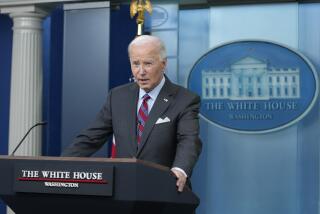Bush’s Efforts in Mideast Yield Progress, Not Peace
WASHINGTON — The conciliatory steps taken Friday by Israelis and Palestinians were the first sign of progress in President Bush’s intense diplomacy aimed at bringing peace to the Middle East.
But they were far from an indication that Bush, who avoided the region for most of his first two years in office, can expect success where several other presidents have failed.
“He’s holding a tiger by the tail,” said Edward S. Walker Jr., president of the Middle East Institute and a former ambassador to Israel.
There was little back-slapping in the White House after the announcements Friday. The only public response was a written statement applauding as a “first significant joint step” the agreement to transfer control of the Gaza Strip and the West Bank town of Bethlehem from Israeli to Palestinian forces. There was only grudging approval of plans by three Palestinian militant groups to declare a three-month cease-fire.
“Anything that lowers the level of violence could be positive,” National Security Council spokesman Sean McCormack said. “But we’re going to remain focused on the job at hand and not get caught up in the cycle of hope and despair.”
National security advisor Condoleezza Rice is scheduled to arrive in Israel today as part of the administration’s drive to pull both sides farther along the Bush-sponsored peace plan known as the “road map.”
Some have wondered whether the peace initiative is still viable after the recent upsurge in violence. The two sides have already missed the plan’s first set of deadlines.
But regional experts say the peace plan will have survived the violence as long as Friday’s steps are followed by new gestures of good faith.
“It’s a very important step,” said Philip C. Wilcox Jr., president of the Foundation for Middle East Peace. “But it will require reciprocity from the Israelis if it’s going to stick.”
Wilcox and others argue that there is an “implicit quid pro quo” for the cease-fire by Hamas, Islamic Jihad and Fatah: Palestinians need to see an improvement in their living conditions, a halt in attacks on their leaders, and an easing of travel restrictions.
Wilcox expressed concern that Israeli Prime Minister Ariel Sharon does not appear ready to take such steps, or to call a halt to the expansion of Israeli settlements in Palestinian areas.
“There is very aggressive settlement growth going on right now,” Wilcox said. “That will have to end very soon if a cease-fire will be able to be sustained.”
Similarly, Walker said, any new attacks by Israel on Hamas leaders also could undermine the tentative progress.
“Any organization like Hamas will not feel compelled to sustain a cease-fire if they see any incidents against other leaders,” Walker said. “I don’t believe [either side] is fully committed to the road map.”
Be that as it may, Bush has made his commitment, sending Rice and Secretary of State Colin L. Powell repeatedly to the region, recalling the “shuttle diplomacy” of the 1970s.
But there are important differences since then, Walker said. For one thing, the Bush administration is not the only mediator; Arab states are also engaged at Bush’s request. And there are three other sponsors of the peace plan: the United Nations, European Union and Russia.
“There will still be violence. Nobody can stop it,” said Judith Kipper, director of the Middle East Forum at the Council on Foreign Relations. “But hopefully it won’t be the same level of violence.”
More to Read
Get the L.A. Times Politics newsletter
Deeply reported insights into legislation, politics and policy from Sacramento, Washington and beyond. In your inbox three times per week.
You may occasionally receive promotional content from the Los Angeles Times.










